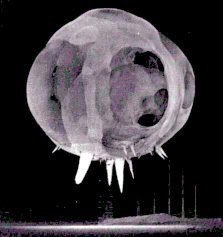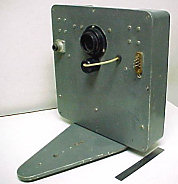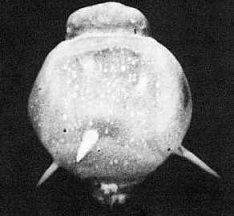 Way back in the 40s when the US was experimenting with atomic bombs there were many problems to overcome. One of which was studying fireball growth at the moment of detonation.
Way back in the 40s when the US was experimenting with atomic bombs there were many problems to overcome. One of which was studying fireball growth at the moment of detonation.
Although photographic technology was growing quickly, even the fastest cameras of the time could not handle the speed at which these fireballs expanded and typically ended up with blurred images at best.
These problems continued until Harold Eugene “Doc” Edgerton a professor from MIT invented the “rapatronic Camera“. So advanced were these cameras, they could capture motion one ten-millionth of a second after detonation and from seven miles away, no less. Exposure time was a mere ten nanoseconds to boot.
Amazingly a fireball could still grow to 100 feet in diameter at such an instant but the cameras were fast enough to enable vital research into one of the many mysteries of an atomic explosion.
It’s still a bit mind bending to many that we had such technology at that time, but humans have developed some technology without the help of space aliens.
Here’s more on this very interesting and groundbreaking photographic technology:
During the early days of atomic bomb experiments in the 1940s, nuclear weapons scientists had some difficulty studying the growth of nuclear fireballs in test detonations. These fireballs expanded so rapidly that even the best cameras of that time were unable to capture anything more than a blurry, over-exposed frame for the first several seconds of the explosion.
Before long a professor of electrical engineering from MIT named Harold Eugene “Doc” Edgerton invented the rapatronic camera, a device capable of capturing images from the fleeting instant directly following a nuclear explosion. These single-use cameras were able to snap a photo one ten-millionth of a second after detonation from about seven miles away, with an exposure time of as little as ten nanoseconds. At that instant, a typical fireball had already reached about 100 feet in diameter, with temperatures three times hotter than the surface of the sun.
Edgerton was a pioneer in high-speed photography, receiving a bronze medal from the Royal Photographic Society in 1934 for his work in strobe photography. He used the technique to photograph many events that typical cameras were much too slow to capture, such as the instant of a balloon bursting, and bullets impacting various materials. He developed the rapatronic camera about ten years later, for the specific purpose of photographing nuclear explosions for the government.
In a typical setup at a nuclear test site, a series of ten or so rapatronic cameras were necessary, because each was able to take only one photograph… no mechanical film advance system was anywhere neat fast enough to allow for a second photo. Another mechanical limitation which had to be overcome was the shutter mechanism. Mechanical shutters were incapable of moving quickly enough to capture the instant one ten-millionth of a second after detonation, so Edgerton’s ingenious cameras used a unique non-mechanical shutter which utilized the polarization of light.
As you’ve probably noticed, if one takes two pieces of polarized glass (such as the lenses from polarized sunglasses) and lays them atop one another at 90° angles, no light is able to pass through. This is because each one filters out light which is not polarized to its polarization axis, so the combination of the two lenses filters out 100% of the light. Edgerton ‘s rapatronic camera appears to have used this property in combination with a Kerr cell– a nifty and obscure optical element which rotates light’s plane of polarization when a high-voltage field is applied.
The rapatronic camera lens included two perpendicular polarizers, which prevented any light from entering… but sandwiched in between them was a Kerr cell. When the Kerr cell was energized, it affected all of the light which passed through the first polarizer by rotating its plane of polarization by 90°, realigning the light to match the second polarizer. This allowed the light to pass through both polarizers whenever the Kerr cell was provided with electricity, which is exactly what was done for 10 nanoseconds at the critical moment. This assembly provided an extremely fast non-mechanical shutter, exposing the film to the light for a minuscule fraction of time.
The resulting extraordinary photographs revealed intricate details of the first instant of an atomic explosion, including a few surprises such as irregular “mottling” caused primarily by variations in the density of the bomb’s casing. It also showed the detail of the “rope trick effect,” where the rapid vaporization of support cables caused curious lines to emanate from the bottom of an explosion. But even aside from the scientific utility of the images, they certainly show that these fantastically destructive nuclear fireballs have a hauntingly beautiful side, even if it only lasts for one ten-millionth of a second.
Source: Damn Interesting
Things like this get you thinking, just how advanced is our own DoD is in development of new technology? We ponder black Ops projects and wonder what they are coming up with under their cloak of secrecy. Is that UFO I saw last night really a new experimental aircraft? Are those strange vibrations and sounds in the night air related to HARRP or maybe something beyond?
Sometimes something that seems as inconsequential as a camera, (which we take for granted now) can trigger world changing events. What if they hadn’t been able to study these fireballs? Would it have slowed down the atomic program too much? Would it have altered the course of history?
And what of that history? Could we have won the war without dropping those atomic bombs? Would we have scrapped the nuclear program altogether?
This can be a reminder that even in our own lives we may do something someday to alter the history of the planet forever. Believe it or not, you have the power to change history, no matter who you are.
Lets hope if and when you do, it’s for the good of humankind.
3 comments





